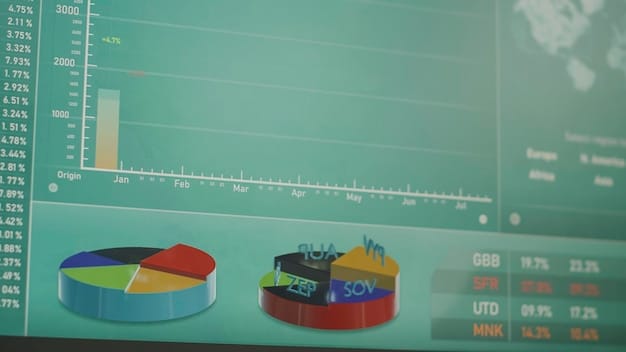The 50/30/20 Budget: Still Relevant in Today’s Economy?

The 50/30/20 budget, a popular method for allocating income, divides resources into needs (50%), wants (30%), and savings/debt repayment (20%), but its relevance in today’s economy is debated due to changing economic landscapes and individual financial priorities.
Anúncios
The 50/30/20 budget is a long-standing guideline for managing personal finances. But does it still hold up in our current economic climate?
Understanding the 50/30/20 Budget Rule
The 50/30/20 budget is a simple yet effective method for managing your finances. It’s designed to help individuals allocate their income in a balanced way, ensuring that essential needs are met while also allowing for some discretionary spending and savings.
The Core Components
At its core, the 50/30/20 budget divides your after-tax income into three main categories: needs, wants, and savings/debt repayment. Let’s break down each of these categories in more detail:
- Needs (50%): These are your essential expenses that are necessary for survival and daily life. This includes housing costs (such as rent or mortgage payments), utilities, transportation (car payments, public transportation fares, or gas), groceries, healthcare, and minimum debt payments.
- Wants (30%): This category covers your discretionary spending, which includes things you enjoy but aren’t strictly necessary. Examples include dining out, entertainment, hobbies, travel, streaming services, and clothing beyond the essentials.
- Savings and Debt Repayment (20%): This portion of your income is allocated toward building your savings, investing for the future, and paying down any outstanding debts beyond the minimum payments. This includes contributions to retirement accounts, emergency funds, and paying off credit card debt or loans.
The beauty of the 50/30/20 budget lies in its simplicity and flexibility. It provides a clear framework for managing your money without being overly restrictive or complicated.
Historical Context of the 50/30/20 Budget
The 50/30/20 budget didn’t emerge overnight. It gained popularity thanks to the work of Elizabeth Warren, a renowned Harvard Law professor and later a U.S. Senator, along with her daughter Amelia Warren Tyagi.
The Book That Popularized the Rule
Warren and Tyagi introduced the 50/30/20 budget in their book “All Your Worth: The Ultimate Lifetime Money Plan,” published in 2005. The book offered a straightforward approach to personal finance, emphasizing the importance of balancing spending, saving, and debt management.
The rule was created with the intention of making personal finance more accessible and less daunting for individuals. By providing a simple framework, Warren and Tyagi aimed to empower people to take control of their financial lives and make informed decisions about their money.
The historical context reveals that the 50/30/20 budget was developed to simplify financial planning and make it more accessible to the general public.
Why the 50/30/20 Budget Might Not Work for Everyone Today
While the 50/30/20 budget has its merits, it’s essential to recognize that it may not be the ideal solution for everyone. Several factors can influence the effectiveness of this budgeting approach in today’s economy.
Varying Income Levels
One of the biggest challenges with the 50/30/20 budget is that it doesn’t account for varying income levels. For individuals with lower incomes, allocating 50% to needs may not be enough to cover essential expenses. Conversely, those with higher incomes may find it difficult to spend 30% on wants.
High Cost of Living
In many urban areas, the cost of living has skyrocketed in recent years. Housing costs, in particular, have become a significant burden for many individuals and families. As a result, allocating 50% to needs may not be sufficient to cover rent, utilities, and other essential expenses.
- Student Loan Debt: Many young adults are burdened with substantial student loan debt, which can significantly impact their ability to save and invest.
- Healthcare Costs: Healthcare expenses continue to rise, placing a strain on household budgets.
- Inflation: Inflation can erode the purchasing power of your income, making it more challenging to stick to a budget.
The rule’s simplicity can also be a drawback. It doesn’t account for individual financial goals, such as saving for a down payment on a home or starting a business. Finally, the 50/30/20 budget may not be suitable for individuals with irregular income.
Adapting the 50/30/20 Budget to Fit Your Needs
If you find that the standard 50/30/20 budget doesn’t quite fit your circumstances, don’t despair. The beauty of this budgeting approach is that it can be adapted to suit your individual needs and financial goals.
Adjusting the Percentages
One of the easiest ways to adapt the 50/30/20 budget is to adjust the percentages to better reflect your priorities and expenses. For example, if you have high housing costs, you may need to allocate more than 50% to needs. Conversely, if you live in a low-cost area, you may be able to allocate less to needs and more to savings or wants.
Similarly, if you have significant debt, such as student loans or credit card debt, you may want to allocate more than 20% to debt repayment. This will help you pay down your debt faster and save money on interest in the long run.
Considering a Zero-Based Budget
Another alternative is to use a zero-based budget, where you allocate every dollar of your income to a specific category. This approach requires more detailed tracking and planning, but it can provide greater control over your finances.
Ultimately, the key is to find a budgeting approach that works for you and helps you achieve your financial goals. Don’t be afraid to experiment with different methods and adjust them as needed.
Alternatives to the 50/30/20 Budget
While the 50/30/20 budget is a popular and effective method for many, it’s not the only budgeting approach available. Several alternatives offer different perspectives on managing your finances.
Envelope System
The envelope system is a cash-based budgeting method where you allocate specific amounts of money to different spending categories each month. You then place the cash in labeled envelopes and only spend from those envelopes. This approach can be particularly helpful for controlling impulsive spending and staying within budget.
Zero-Based Budget
As mentioned earlier, the zero-based budget involves allocating every dollar of your income to a specific category. This approach requires more detailed tracking and planning, but it can provide greater control over your finances. You start with your income and then subtract all your expenses, savings, and debt repayment until you reach zero.
- Tracking Every Expense: This method involves recording every single expense, no matter how small. You can use a budgeting app, spreadsheet, or notebook to track your spending.
- Automated Budgeting: Several budgeting apps can help you automate your budgeting process. These apps can track your spending, categorize your transactions, and even allocate funds to different categories automatically.
Consider your financial goals, income level, and spending habits when choosing a budgeting approach. It’s also important to review and adjust your budget regularly to ensure that it continues to meet your needs.
The Future of Budgeting: Adapting to New Economic Realities
The economic landscape is constantly evolving, and the future of budgeting will likely involve further adaptation and innovation. New technologies, changing consumer behavior, and economic trends will all play a role in shaping how we manage our finances.
Financial Technology
Financial technology, or fintech, is already transforming the way we budget and manage our money. Budgeting apps, automated savings tools, and robo-advisors are making it easier than ever to take control of your finances.
As technology continues to evolve, we can expect to see even more innovative budgeting tools and platforms emerge. These tools will likely leverage artificial intelligence, machine learning, and data analytics to provide personalized financial advice and insights.
It’s essential to stay informed about these trends and adapt your budgeting approach accordingly. By embracing new technologies and strategies, you can stay ahead of the curve and achieve your financial goals.
| Key Point | Brief Description |
|---|---|
| 💰 The 50/30/20 Rule | Divides income into needs (50%), wants (30%), savings/debt (20%). |
| 📈 Economic Relevance | Current relevance depends on income, cost of living, and financial goals. |
| 🛠️ Budget Adaptation | Adjust percentages or consider zero-based budgeting. |
| 📱 Future of Budgeting | Fintech and AI will continue to transform budgeting practices. |
Frequently Asked Questions (FAQ)
▼
No, the 50/30/20 budget may not be suitable for everyone due to varying income levels, cost of living, and individual financial goals. It’s essential to adapt the budget to fit your specific circumstances.
▼
If your needs exceed 50% of your income, you may need to adjust the percentages or find ways to reduce your essential expenses. Consider cutting back on wants or increasing your income.
▼
You can track your spending using budgeting apps, spreadsheets, or a notebook. Regularly review your expenses to ensure you’re staying within your allocated percentages. Automating your savings can also help.
▼
Alternatives to the 50/30/20 budget include the envelope system, zero-based budgeting, and tracking every expense. Each approach offers different perspectives on managing your finances.
▼
Technology will continue to transform budgeting through fintech, AI, and automated savings tools. These innovations will provide personalized financial advice and insights, making it easier to manage your money.
Conclusion
In conclusion, while the 50/30/20 budget provides a solid foundation for financial planning, it’s essential to adapt it to your unique circumstances. By adjusting the percentages, exploring alternative budgeting methods, and embracing new technologies, you can take control of your finances and achieve your financial goals in today’s ever-changing economy.







